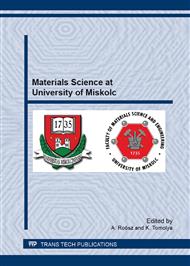[1]
Sándor Pálinkás, János Tóth: Investigation of the flatness of rolled aluminium sheet, International Review of Applied Sciences and Engineering, 2(1) 2011, pp.57-62.
DOI: 10.1556/irase.2.2011.1.9
Google Scholar
[2]
Norman Mathieu, Régis Dimitriou, Anthony Parrico, Michel Potier-Ferry, Hamid Zahrouni: Flatness defects after bridle rolls: a numerical analysis of leveling, International Journal of Material Forming, Published online 15 November (2011).
DOI: 10.1007/s12289-011-1083-2
Google Scholar
[3]
Vladimir B. Ginzburg, Robert Ballas: Flat Rolling Fundamentals, Marcel Dekkel, Inc., New York and Basel, (2000).
Google Scholar
[4]
Yoshiaki Takashima, Akihiro Kamatani, Masatomo Terakawa, Kazuo Hirase, Kanji Kizaki, Takashi Emori, Hisashi Honjyo, Tsutomu Hara: Studies on Strip Crown Control for Hot Strip Rolling – Double Chock Work Bending System (DC-WRB), IHI Engineering Review, Vol. 12 No. 3, 1979, pp.28-34.
Google Scholar
[5]
Takashi Ishikawa, Nobuki Yukawa, Yasuhisa Tozawa: Analytical approach to occurrence and suppression of flatness defect in strip rolling, 4th International Steel Rolling Conference-the Science and Technology of Flat Rolling. Vol. 2; Deauville; France; 1-3 June (1987).
Google Scholar
[6]
Prakash M. Dixit, Uday S. Dixit: Modelling of Metal Forming and Machining Processes, Springer- Verlag London, (2008).
Google Scholar
[7]
John G. Lenard: Metal Forming Science and Practice, Elsevier Science Ltd., (2002).
Google Scholar
[8]
R.R. Somers, G.T. Pallone, J.F. Mcdermott, W.H. Harris, Verification and Applications of a Model for Predicting Hot Strip Profile, Crown and Flatness, AISE Year Book, 1984, pp.441-450.
Google Scholar
[9]
Arif S. Malik, Ramana V. Grandhi: A computational method to predict strip profile in rolling mills, Journal of Materials Processing Technology 206 (2008) pp.263-274.
DOI: 10.1016/j.jmatprotec.2007.12.026
Google Scholar
[10]
Pierre Montmitonnet: Hot and cold strip rolling processes, Computer Methods in Applied Mechanics and Engineering 195 (2006) 6604–6625.
DOI: 10.1016/j.cma.2005.10.014
Google Scholar
[11]
S. Abdelkhalek, P. Montmitonnet, N. Legrand, P. Buessler: Coupled approach for flatness prediction in cold rolling of thin strip, International Journal of Mechanical Sciences 53 (2011) 661–675.
DOI: 10.1016/j.ijmecsci.2011.04.001
Google Scholar
[12]
MSC Software. Marc 2011 Volume A: Theory and User Information.
Google Scholar
[13]
Vladimir B. Ginzburg: Steel-Rolling Technology – Theory and Practice, Marcel Dekkel, Inc., New York and Basel, (1989).
Google Scholar


